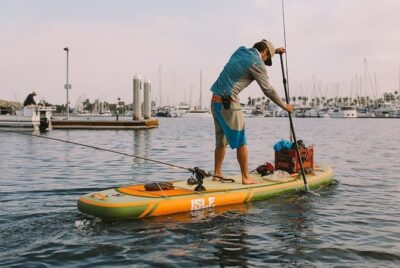How Do Weight Limits On A Paddleboard Work? Detailed A-Z Guide
*We may earn a commission for purchases made using our links. Please see our disclosure to learn more.
Got a paddleboard but unsure about its weight limit? Or maybe you’re thinking of grabbing a SUP but you just want to make sure that it’s the right fit for you.
In this article, we’ll clear up all your queries around the weight capacity of different types of paddle boards, whether it’s an inflatable board or a hard one.
Dive in to ensure you’re optimizing your board use and enjoying safe paddling adventures! 💦🌊🏄♂️
| Looking for our best paddle board product recommendations? Check the Paddleboard Insiders Buyer Guides |
Table Of Contents
- What is a Paddleboard Weight Limit?
- Factors Affecting Paddleboard Weight Limit
- Recommended Paddleboard Weight Limit
- Exceeding the Weight Limit
- How to Determine the Right Weight Limit for You
- Increasing a Paddleboard Weight Limit
- Conclusion
- FAQs
- What is the weight limit on a paddle board?
- How do I know my stand-up paddle board’s weight capacity?
- Can inflatable stand-up paddle boards support heavy weights?
- Is there a practical weight limit for tandem paddle boarding?
- Can one exceed their Stand-Up Paddle Board’s suggested Weight Limit?
- What if my combined fishing gear and personal load exceeds my fishing SUP’s maximum recommended load?
What is a Paddleboard Weight Limit?
A paddleboard weight limit refers to the maximum amount of weight that a paddleboard can safely support without compromising performance or risking damage to the board.
Definition and importance
A paddleboard weight limit defines the maximum load a board can handle while maintaining optimal performance and safety. It is crucial in determining how much weight, including the rider and any gear, a paddle board can accommodate without being unstable or sinking.
Ignoring this limit might compromise your balance on water, making paddling more difficult than necessary.
Manufacturers determine these limits based on different factors like length, volume, material construction and shape of the board.
Therefore, every model comes with its own specific weight limit detailed in pounds (lbs). This essential factor allows you to match a suitable paddleboard to your body weight plus gear for an effective and safe stand-up paddleboarding experience.
Factors Affecting Paddleboard Weight Limit
The size, design, and material used in a paddleboard can all affect its weight limit. Learn more about these factors and how they impact your paddleboarding experience.
Here is everything you need to know about the different SUP shapes and how they affect the weight limit:
If you’re not a video person (like me) then let’s dive more into the specifics below.
Board Size and Design
Board size and design significantly influence the paddle board’s weight limit. Larger boards commonly offer higher weight capacities, providing more surface area to distribute the load evenly.
The length, width, and thickness of a stand-up paddleboard all play crucial roles in determining its maximum capacity. Longer paddleboards tend to have higher weight limits as they displace more water, creating additional buoyancy.
Similarly, wider boards provide greater stability by increasing balance under heavier loads. In contrast, thinner boards are lighter but typically boast lower weight limits due to their reduced volume.
Understanding these elements can guide you towards choosing the right paddleboard that satisfies your needs without compromising on performance or safety.
Material used
Paddleboard materials greatly influence their weight limit and overall performance. Manufacturers often utilize materials like military-grade PVC for inflatable boards, which are light but durable enough to support weights between 285 and 500 pounds.
Here is how inflatable paddleboards are constructed:
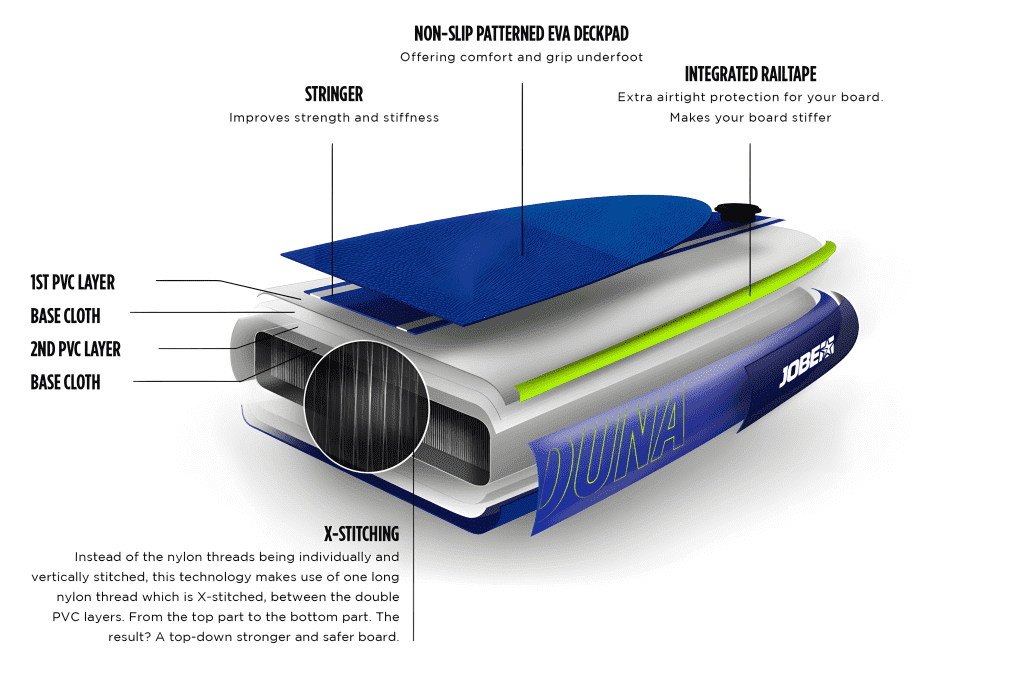
Epoxy or fiberglass is common in solid stand-up paddle boards, offering a good balance of strength and weight capacity. With an Atoll board known for supporting up to 700 pounds, it’s clear that the choice of material plays a crucial role in determining how much weight a paddleboard can hold safely.
Here is how a fiberglass paddleboard is constructed:
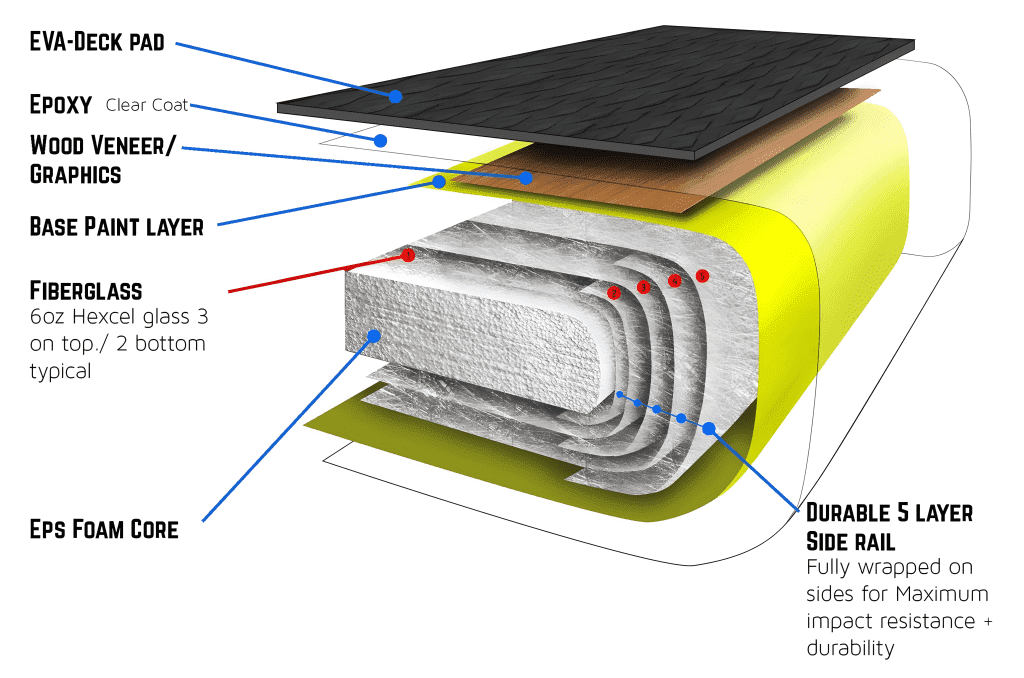
Long-lasting reliability becomes possible when high-quality materials merge with smart design.
Inflatable vs. solid paddleboards
In terms of weight capacity, both inflatable and solid paddleboards have their pros and cons.
| Type Of Paddle Board | Weight Limit Pros | Weight Limit Cons |
| Inflatable Paddle Boards | Inflatable paddle boards can support weights between 285 and 500 pounds, depending on the size. | Although they have a good weight capacity, inflatable paddleboards may not be as stable as solid ones when nearing their weight limit. |
| Solid Paddle Boards | Solid paddleboards are generally more stable and can often support higher weights. The Atoll paddleboard, for instance, can support up to 700 pounds. | While solid paddleboards can support more weight, they are usually heavier themselves and may be harder to transport and store. |
It’s important to consider your own weight and needs when choosing between an inflatable and solid paddleboard. It’s also crucial to adhere to the manufacturer’s specified weight limit to ensure optimal performance and safety.
Recommended Paddleboard Weight Limit
The recommended paddleboard weight limit varies depending on the type of board, with average limits for standard paddleboards and higher limits for specialized boards designed to support more weight.

Average weight limit for standard paddleboards
Standard paddleboards typically have an average weight limit ranging from 200 to 500 pounds. This means that the board can safely support a person’s body weight along with their gear and any additional weight.
It is important to consider this weight limit when choosing a paddleboard to ensure optimal performance and stability on the water. Additionally, longer paddleboards tend to have higher weight limits, allowing for more versatility in terms of riders and gear.
By staying within the recommended weight limit, you can enjoy a safe and enjoyable stand up paddleboarding experience.
| Looking for the best paddleboards on the market right now? Best Paddleboard Brands: Our Top Recommendations For 2023 |
Higher weight limits for specialized paddleboards
Some paddleboards are specifically designed to handle higher weight limits, catering to individuals who require additional support and stability on the water. These specialized paddleboards can accommodate weights ranging from 500 to 700 pounds, providing a reliable option for heavier riders or those looking to carry extra gear.
With their reinforced construction and enhanced buoyancy, these boards ensure optimal performance and safety even with increased weight. Whether you’re tandem paddleboarding or simply need more capacity for your fishing equipment, these higher weight limit paddleboards offer the durability and functionality you need for your unique paddling adventures.
Best Higher Weight Paddleboard: Atoll 11″ iSUP
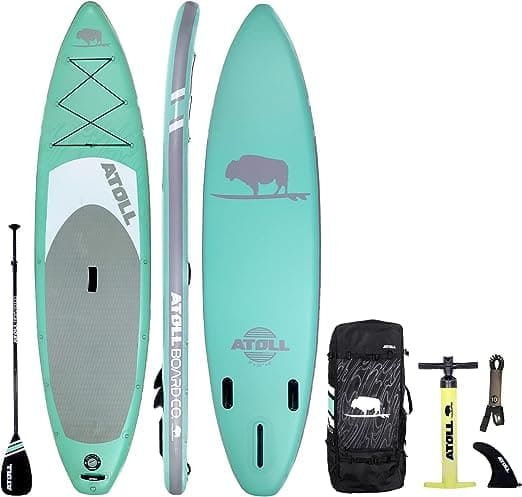
Where To Buy: Amazon
Key Features:
– Allows up to 400lb in weight
– 11’0″ in size
– Comes with bag, leash, fin and paddle
– 2 year warranty on materials
I’ve got friends that are on the heavier side that have constantly struggled to find paddleboards that don’t sink when they sit on them. And the Atoll board is probably the best SUP on the market for that need. It’s a great board for any water situation, and for its inexpensive price… it is a SUP that you should really look into.
Exceeding the Weight Limit
Exceeding the weight limit on a paddleboard can negatively impact its performance and increase the risk of damage to the board.
Effects on performance
Exceeding the weight limit of a paddleboard can have negative effects on its performance. When you surpass the recommended weight capacity, the board may ride lower in the water, making it less stable and harder to maneuver.
This can affect your ability to paddle smoothly, maintain balance, and enjoy your stand-up paddleboarding experience. Additionally, carrying excess weight can cause the board to become sluggish and slow, reducing its overall performance.
It is important to stay within the designated weight limit specified by the manufacturer to ensure optimal performance and safety while out on the water.
You don’t want to end up like the guy in the image.
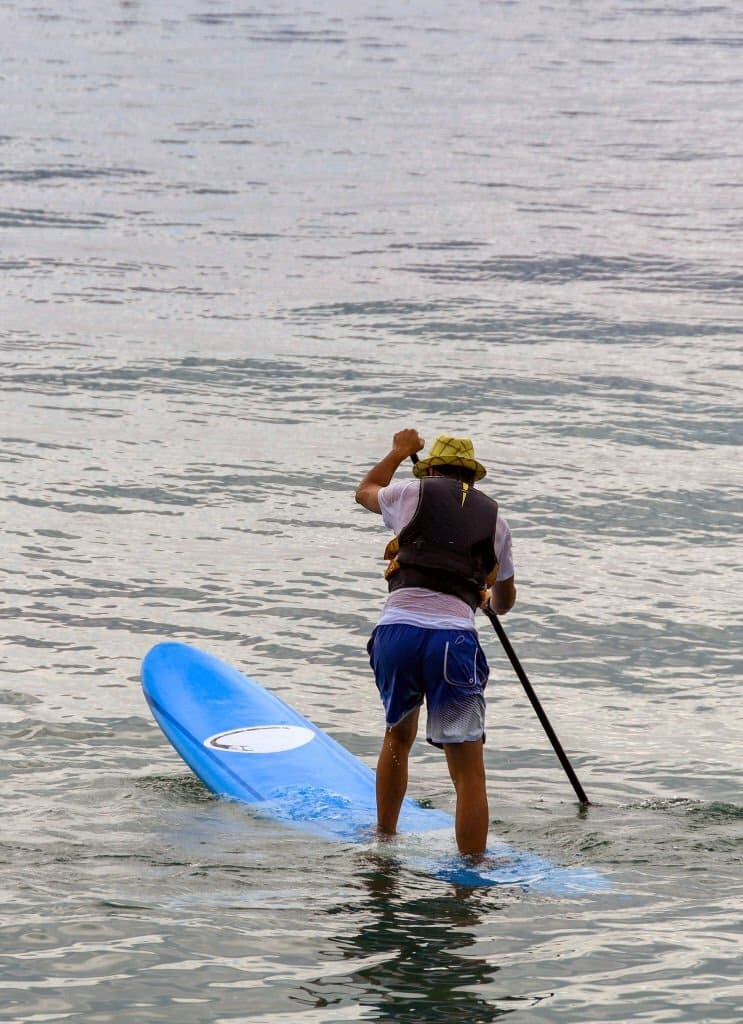
Risk of damage to the board
Exceeding the weight limit of a paddleboard can pose a risk of damage to the board itself. When a paddleboard is overloaded, it may become unstable and ride lower in the water, increasing the likelihood of hitting rocks or other obstacles.
This can result in scratches, dents, or even structural damage to the board. Additionally, exceeding the weight limit puts extra strain on the materials used to construct the board, such as epoxy or inflatable materials.
Over time, this can weaken the board and lead to cracks or leaks. Therefore, it’s crucial to stay within the recommended weight limit specified by the manufacturer to ensure both your safety and that of your paddleboard.
How to Determine the Right Weight Limit for You
Calculate the buoyancy of the paddleboard, consider your own weight and gear, and choose a paddleboard that is suitable for your size and needs.
Calculating buoyancy
To determine the right weight limit for your paddleboard, you can calculate its buoyancy. Here are some factors to consider:
- Your body weight: Start by considering your own weight. This will be the primary factor in determining the weight limit you should look for in a paddleboard.
- Gear weight: Think about any additional gear you plan to bring with you on your paddleboarding adventures. This could include items like a cooler, backpack, or fishing equipment. Make sure to add up the weights of these items and factor them into your overall weight capacity calculations.
- Total weight: Once you have accounted for your bodyweight and the weight of your gear, sum them together to determine the total weight that the paddleboard needs to support.
- Manufacturer recommendations: Take into account any specific recommendations or guidelines provided by the manufacturer regarding weight limits for their paddleboards. These recommendations are typically based on factors such as board design, materials used, and intended use.
Choosing the right paddleboard for your size and needs
When selecting a paddleboard, it is important to consider your size and specific needs. Here are some factors to consider:
- Weight Limit: Determine the weight limit of the paddleboard and ensure it can comfortably support your body weight along with any additional gear you may be carrying.
- Board Length and Width: Longer and wider boards generally have higher weight limits as they provide more stability and buoyancy in the water.
- Board Volume: Higher volume boards can support more weight, so take into account the board’s volume when choosing a suitable paddleboard for your size.
- Material: Different materials used in paddleboards may affect their weight capacity. Epoxy boards tend to have higher weight limits compared to inflatable boards.
- Design: Some paddleboards are specifically designed for heavier riders or for tandem paddling, so consider these specialized options if needed.
- Activity Type: Consider the type of paddling you will be doing (e.g., recreational, touring, surfing) and choose a board that is suitable for that activity while still accommodating your weight.
| Here are some of the best paddle boards you can get on a budget: 7 Incredible Beginner Paddleboards To Buy In 2024 On A Budget |
Increasing a Paddleboard Weight Limit
Is it possible to increase the weight limit of a paddleboard?
Increasing the weight limit of a paddleboard is not possible. Paddleboards are designed with specific weight capacities to ensure optimal performance and safety. Exceeding the weight limit can result in poor stability, reduced maneuverability, and even damage to the board itself.
It is important to choose a paddleboard that can accommodate your body weight and any additional gear you may have without exceeding its recommended maximum capacity. Always follow the manufacturer’s guidelines to ensure an enjoyable and safe paddleboarding experience.
Tips for increasing weight capacity
To increase the weight capacity of your paddleboard, you can consider the following tips:
| Choose a larger board size: | Longer and wider boards tend to have higher weight limits. |
| Opt for a solid paddleboard: | Solid boards made from materials such as epoxy can often support more weight compared to inflatable boards. |
| Look for thicker boards: | Thicker paddleboards tend to provide better buoyancy and can handle more weight. |
| Consider specialized paddleboards: | Some models are designed specifically for carrying heavier loads, such as tandem or fishing paddleboards. |
| Use military-grade PVC material: | Inflatable paddleboards made with durable materials can have higher weight limits. |
| Check the maximum weight capacity of specific models: | Manufacturers often specify the maximum weight their boards can safely hold. |
| Distribute weight evenly: | When paddling with multiple riders or carrying additional gear, distribute the weight evenly across the board to maintain stability and prevent overloading. |
Conclusion
In conclusion, understanding the weight limit of a paddleboard is crucial for ensuring optimal performance and safety. Exceeding the weight limit can result in poor stability and reduced maneuverability on the water.
By selecting a paddleboard that can accommodate your body weight and gear, you can enjoy a smooth and enjoyable paddleboarding experience. Remember to always check the manufacturer’s specifications to determine the appropriate weight limit for your needs.
And more importantly – Enjoy!
| Looking for insider guides to some amazing paddle boarding locations? Check the Paddleboard Insiders Location Guides |
FAQs
What is the weight limit on a paddle board?
The weight limit on a paddle board varies depending on its volume and length x width but often ranges from 200 to 500 pounds.
How do I know my stand-up paddle board’s weight capacity?
You can determine your stand-up paddle board’s weight capacity by checking the suggested maximum limit provided by the manufacturer.
Can inflatable stand-up paddle boards support heavy weights?
Yes, most inflatable SUP (Stand Up Paddle) boards made from military-grade PVC material are designed to hold up to 400 lbs.
Is there a practical weight limit for tandem paddle boarding?
For tandem paddling, you should consider both riders’ combined weight against the sup’s maximum weight limits to ensure safety and stability during your paddle boarding journey.
Can one exceed their Stand-Up Paddle Board’s suggested Weight Limit?
Exceeding your SUP’s suggested Weight Limit could impact how well it rides in water and may affect its performance negatively even though higher-weight limits tend to offer more stability.
What if my combined fishing gear and personal load exceeds my fishing SUP’s maximum recommended load?
While some Epoxy Paddleboards or certain thicker rail models might support multiple riders or extra gear beyond specified limits, generally overloading any Board model risks compromising buoyancy and durability.




